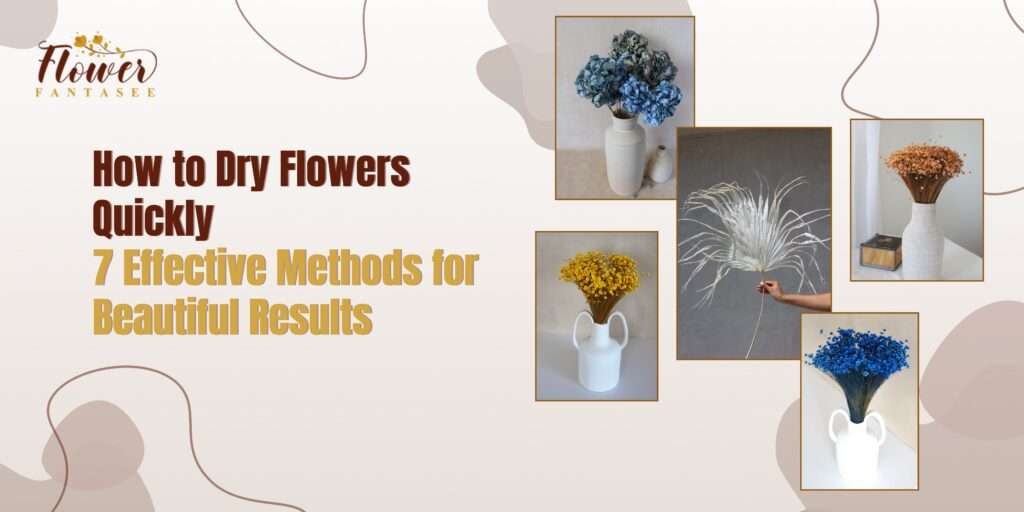Drying flowers is a great method for maintaining their original attractiveness and adding an element of organic elegance to your decor all year. Discovering how to dry flowers quickly and correctly is vital for preserving a beautiful bouquet, creating beautiful crafts, or simply relaxing with dried arrangements of flowers. In this blog, we’ll look at seven useful methods to dry flowers quickly while preserving their inherent beauty

Why Dry Flowers?
There are various reasons why drying flowers is prevalent:
- Home Décor: Dried flowers lend a rustic, classic look to any room.
- Crafting: Suitable for making wreaths, potpourri, and painting.
- Memories: Save flowers from significant moments in life or bouquets from family and friends.
1. Microwave Drying
Microwave drying serves as one of the simplest ways to dry flowers while preserving their brilliant colors.
Steps Involved:
- Prepare Your Flowers: Gather new blossoms and trim their stems.
- Use Silica Gel: Place the flowers in a microwave-safe vessel and cover them using silica gel to keep them in proportion.
- Microwave: Heat at a moderate temperature for about 2-3 minutes, watching progress frequently to prevent over-drying.
- Cooling: Allow the flowers to cool in the silica gel for approximately 24 hours before extracting.
2. Oven Drying
Another simple approach for drying bigger numbers of flowers is by employing an oven.
Steps:
- Prepare Your Flowers: Gather your flowers by isolating the stems and positioning them on a baking sheet having parchment paper.
- Preheat Oven: Lower the temperature of the microwave down to the least capacity which is about 150-200°F or 65-95°C depending on the modernity of the microwave.
- Drying: Put the flower petals in the heated oven for dehydration for 2-3 hours while checking on them from time to time.
- Cooling: Let the flowers cool entirely before utilizing them in your handmade creations.
3. Air Drying with a Fan
Air drying is a conventional technique that can be done at an accelerated rate by using a fan; it is suitable for delicate flowers.
Steps:
- Prepare Your Flowers: Take flowers bundle them together in small groups, and secure the stems with a string.
- Hang Upside Down: Ensure that the bunches are hung in a proper place that has good air circulation.
- Use a Fan: Put a fan nearby to help with the circulation so that the area dries faster within a few days.
- Monitor: Check the flowers daily until they are completely dry.
4. Pressing Flowers
Compressing flowers is an easy approach to generating flat, preserved bouquets for art projects.
Steps:
- Prepare Your Flowers: Select flat flowers or eliminate bulky components.
- Arrange in a Book: Arrange the flowers among sheets of parchment paper and into a hefty book.
- Add Weight: Stack additional reading material or objects on top to keep the flowers flat.
- Wait: Allow the flowers to air out for 1-2 weeks before ensuring they are entirely dry.
5. Silica Gel Drying
Silica gel drying is a wonderful way to learn how to dry flowers quickly to keep them in a definite shape as well as color.
Steps:
- Prepare Your Flowers: Trim the branches and store the flowers in an airtight container.
- Add Silica Gel: Coat the petals entirely with silica gel crystals.
- Seal and Wait: Close the jar and store it for 1-2 weeks.
- Remove Flowers: Thoroughly separate the dried flowers from the silica gel.
6. Glycerin Method
The glycerin technique is perfect for drying flowers while leaving them pliable and slightly elastic.
Steps:
- Prepare Your Flowers: Remove the leaves and branches, then mix a single portion of glycerin with a portion of boiling water.
- Soaking: Soak the roots in the glycerin solution for 2–3 weeks.
- Check: Following absorption of the glycerin, the petals will have an elastic and bendable texture.
7. Dehydrator Drying
Using a food dehydrator is a fast and effective manner to dry flowers, especially if you currently own one.
Steps:
- Prepare Your Flowers: Trim the flower stalks and place them in the baking sheets employed in the dehydrator.
- Set Temperature: Preheat the dryer to approximately 100°F (38°C).
- Drying: Allow the flowers to air out for 2-4 hours, monitoring in often.
- Cooling: Allow the flowers to rest entirely before utilizing them.
Tips for Perfectly Dried Flowers
- Select Fresh Flowers: For the best results, select flowers that have just been gathered or received.
- Avoid Direct Sunlight: To retain the vibrant hue of your flowers, dehydrate them in a cool, dark location.
- Handle with Care: Flowers that have dried are delicate. Handle them cautiously to avoid breaking.
Creative Uses for Dried Flowers
Once your flowers dry out, the choices are limitless. Here are some ideas:
- Floral Art: Assemble framed pieces with pressed flowers.
- Homemade Potpourri: Bake dried flowers and herbs with natural oils and spices in the oven to develop a scent that is like a warm hug.
- Decorative Wreaths: You can also create festive garlands to hang on the front door or the walls.
- Gift Wrapping: Use dried flowers accompaniments on gifts of your preference.
Conclusion
Drying flowers is an organic procedure that may be performed at home and is satisfying in the sense that the perfume of the flowers remains apparent even after they have withered to some extent. When it involves drying flowers, you can attempt microwave drying, oven drying, air drying, pressing, using silica gel, glycerin, or a dehydrator, because every technique offers a unique approach and technique which makes it extremely time consuming and technical.Thinking, about how to dry flowers quickly? For a seamless experience and to maximize efficiency, consider obtaining your dried flowers directly from FlowerFantaSee. They specialize in providing high-quality dried flowers that will elevate your decor and crafting projects with their natural beauty.